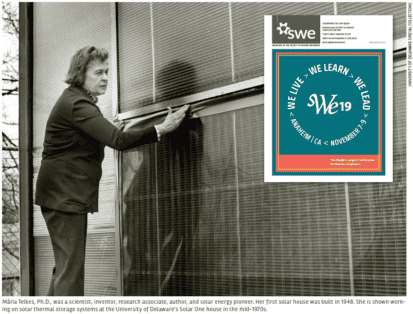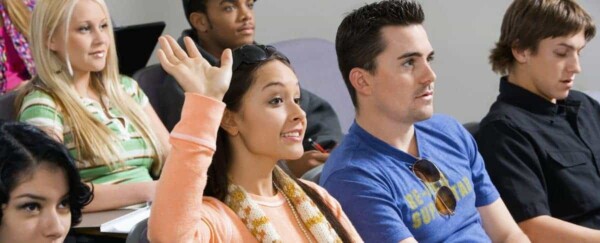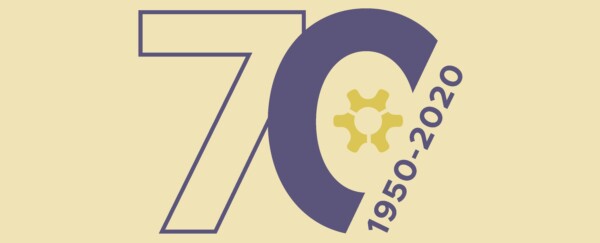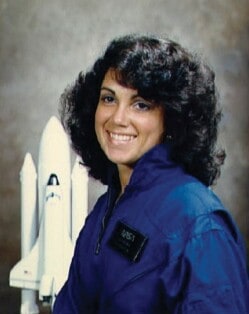 Ten days before the Challenger disaster, Judith Resnik, Ph.D., took time out from a hectic, pre-launch work schedule to write a brief, handwritten note of encouragement to a NASA colleague’s young niece. She ended the note with the following advice: “Study hard in school — it’s really worth it! When you’re older, you’ll be able to do anything you want if you get a good education.”
Ten days before the Challenger disaster, Judith Resnik, Ph.D., took time out from a hectic, pre-launch work schedule to write a brief, handwritten note of encouragement to a NASA colleague’s young niece. She ended the note with the following advice: “Study hard in school — it’s really worth it! When you’re older, you’ll be able to do anything you want if you get a good education.”
Dr. Resnik loved learning, both the indirect kind available through books and formal classroom instruction and the direct kind that can be acquired only through firsthand experience. She pursued both with dedication and conviction.
“She always did her homework,” her father, Marvin Resnik, O.D., an optometrist, once told a reporter. “[Judy would say] the luckiest people are the ones who work the hardest. The director of NASA said that Judy was an astronaut’s astronaut. She did everything right.”
Bright, highly competitive, and disciplined, Dr. Resnik demanded excellence in everything she did. In school, she excelled in math, chemistry, French, and classical piano — which she studied and performed with great intensity. She graduated first in her class at Firestone High School in Akron, Ohio, and she received early acceptance to The Juilliard School, where she had planned to train for a career as a classical pianist.
Those plans changed abruptly when Dr. Resnik scored an 800 on the math portion of her college SATs. She was the only female U.S. high school student that year to achieve a perfect score — and only the 16th young woman ever to do so. The test results clearly showed that Dr. Resnik’s math aptitude — and potential — far exceeded her other formidable skills, even her talent at the piano.
With that in mind, Dr. Resnik enrolled in Carnegie Tech (now Carnegie Mellon University) in Pittsburgh, where she pursued a B.S. degree in mathematics. She later switched her major to electrical engineering when she found she preferred its less theoretical approach to problem-solving.
Dr. Resnik loved to pursue new challenges, something her mentor at Carnegie Tech, Angel Jordan, Ph.D., later said had motivated her to apply for, and ultimately join, the NASA Astronaut Corps.
In her pursuit of excellence, Dr. Resnik acquired both a master’s and a Ph.D. in electrical engineering from the University of Maryland — expertise that later caught the eyes of NASA recruiters. Those advanced degrees helped Dr. Resnik reach low-earth orbit as America’s second woman in space and as a highly respected member of NASA’s shuttle team.
Since the accident, Dr. Resnik’s love of education has been memorialized through more than 20 academic scholarships. Her namesakes now include several public schools, a university dormitory, a sculpture garden, a star, a crater on the far side of the moon and another on Venus, an IEEE award, and SWE’s prestigious Resnik Challenger Medal. In 1998, she also was memorialized in the play “Reach for the Stars.” Inspired by her life events, the play was performed throughout the Cleveland metropolitan area.
SWE’s Judith Resnik Memorial Scholarship, established in 1990, has helped dozens of remarkable, young SWE members reach for the stars in their own lives, as they have pursued undergraduate degrees in aerospace and astronautical engineering. Many of them identify closely with, and admire, Dr. Resnik, who was an active senior member of SWE. And each, in her own way, embodies some of Dr. Resnik’s most admirable traits.
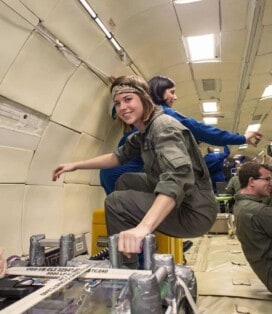
Failure is not an option
In 2011, toward the end of her senior year at Arizona State University (ASU), Alison Gibson realized that she had picked the wrong major. Cognitive psychology, with a focus on neuroscience, had been interesting but it wasn’t aerospace engineering, the degree she had intended to pursue all along. She still hoped it would give her entrée to the space industry — and a shot at her lifelong dream of becoming an astronaut. It was a dream she gradually realized she wasn’t ready to abandon.
Convinced that she could defeat the self-doubt that had derailed her plans the first time around, Gibson decided to do what most people would have considered unthinkable: She immediately enrolled as a first-year student in ASU’s aerospace engineering program and began to pursue a second four-year undergraduate degree. Only this time, the odds clearly would be stacked against her.
Gibson had used up the full-ride academic scholarship Arizona had given her as a high-achieving, first-time, in-state student, and that meant she would now have to work her way through school while attempting to master aerospace engineering’s far-more-demanding course work. “It was kind of crazy,” Gibson acknowledged, in retrospect.
Nevertheless, she began working two research jobs and threw herself into her studies. To her surprise, Gibson discovered she could handle the work. She would ultimately graduate, in 2015, summa cum laude, with a 3.93 GPA. “I ended up … feeling that it was a good fit for me,” she explained. “I kind of thrived in that program.”
Toward the end of her sophomore year, Gibson, who was then a SWE professional member, applied for the Judith Resnik Memorial Scholarship. She knew about Dr. Resnik’s life and accomplishments and thought of her as a role model.
SWE awarded Gibson the scholarship at the start of her junior year. The financial aid and its attachment to the Resnik legacy made a huge impact on her personally, academically, and, ultimately, in her career. “The Judith Resnik Scholarship certainly made me feel like my dreams [of becoming an astronaut] were possible and inspired me to keep that vision clear,” Gibson said. “And the fact that a group of people — the SWE scholarship committee — could see my passion on paper and believed I had potential was incredibly validating.”
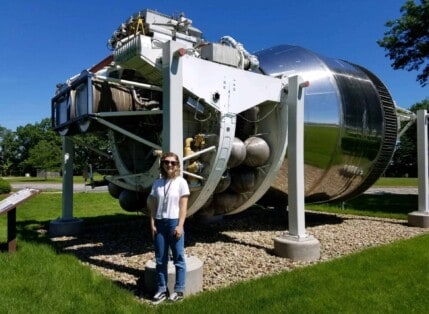
The financial aid, she said, helped make her a better engineer. “It profoundly impacted my development as an engineer by allowing me to apply classroom theory to hands-on projects. I believe that this additional research/project experience further refined my understanding of engineering concepts and made me a much stronger candidate for graduate school.”
Gibson credits that extra hands-on experience, and the “big-picture understanding of engineering” that came with it, for helping her land two important avionics summer internships with SpaceX. Later, those internships and separate engineering research papers she had published while attending ASU helped Gibson qualify for graduate work in the Massachusetts Institute of Technology’s Man Vehicle Laboratory (renamed the Human Systems Laboratory in 2018), which focused exclusively on human spaceflight research. That opportunity, in turn, helped her obtain a permanent position at SpaceX after she graduated.
Today, Gibson works as a guidance, navigation, and control engineer for the SpaceX Crew Dragon spaceship program, where she helps develop software that controls the fully autonomous vehicle. Last May, when Crew Dragon delivered two NASA astronauts to the International Space Station (ISS) for the first time, demonstrating the vehicle’s ability to successfully take humans into low-earth orbit, Gibson was seated in Mission Control, where she served as the flight’s navigation officer.
“It was super exciting,” she said. “Ten years ago, if someone had told me this is where I’d be, I would have been very surprised — but also very impressed and excited.”
Gibson still has dreams of becoming an astronaut. “I would love to go to the moon. I think that would be an epic adventure,” she said.
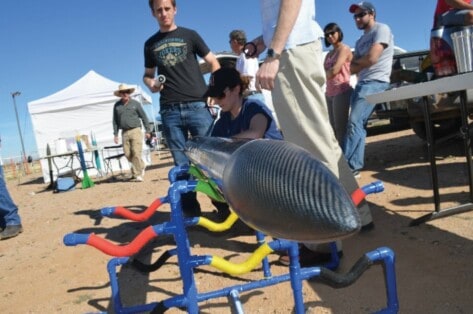 Two-time Judith Resnik scholarship recipient Tianna Stefano readies the sustainer (upper) stage of her senior design team’s smart, two-stage, carbon-composite rocket to receive its solid-fuel rocket motor. The ambitious year-long engineering design-build project, which Stefano led and which featured additive manufacturing processes, took first place in the University of Arizona’s 2014 Engineering College Design Day competition. Stefano credits the financial aid she received from the Resnik scholarships with freeing up her time to pursue such extracurricular activities. She said the positive recognition she received for winning the national scholarship “boosted my self-confidence and self-worth immensely and acted as a springboard to encourage me to take on more challenges.” Afterward, Stefano went on to graduate magna cum laude and to be named “Outstanding Aerospace Engineering Senior” for both her demonstrated work ethic and for the substantial contributions she made to her research and design projects.
Two-time Judith Resnik scholarship recipient Tianna Stefano readies the sustainer (upper) stage of her senior design team’s smart, two-stage, carbon-composite rocket to receive its solid-fuel rocket motor. The ambitious year-long engineering design-build project, which Stefano led and which featured additive manufacturing processes, took first place in the University of Arizona’s 2014 Engineering College Design Day competition. Stefano credits the financial aid she received from the Resnik scholarships with freeing up her time to pursue such extracurricular activities. She said the positive recognition she received for winning the national scholarship “boosted my self-confidence and self-worth immensely and acted as a springboard to encourage me to take on more challenges.” Afterward, Stefano went on to graduate magna cum laude and to be named “Outstanding Aerospace Engineering Senior” for both her demonstrated work ethic and for the substantial contributions she made to her research and design projects.
Staying the course
Since they were kids in rural southern California, Sara Miller and her older brother, Matt, dreamed of someday becoming astronauts and exploring space together.
Their parents dubbed their shared obsession “The Miller Family Space Race,” and nudged their kids’ dream along — with frequent visits to the San Diego Air and Space Museum and lots of space- and astronaut-themed birthday parties. The Miller children also slept under bedroom ceilings aglow with their mother’s hand-painted planets and stars.
“My parents really encouraged our shared interest,” Miller recalled, “and we just never gave it up” — although Miller did come dangerously close to abandoning her dream early in her senior year at the Georgia Institute of Technology.
Miller had been pursuing the academically intense, mission-specialist route to the astronaut corps pioneered by some of her favorite women astronauts: Sally Ride, Dr. Resnik, and Shannon Walker. All three women had completed Ph.D.’s in their respective areas of study — at a time when NASA’s educational requirements stopped at the undergraduate level.
Then, Miller received an offer of future employment from NASA’s Glenn Research Center in Cleveland, where she had completed several internships. The job would require her to help astronauts aboard the ISS configure solar arrays to power microgravity experiments. Miller received the offer early in her senior year, and if she accepted it would have reported for work after graduation.
Miller recalls being thrilled at the prospect of working there. “Earning a real paycheck,” she said, “ditching the late nights studying for midterms, and working with the astronauts aboard the ISS, was a tempting proposition, to say the least.”
She also was feeling run down from the effort it took to graduate with honors in Georgia Tech’s aerospace, aeronautical, and astronautical engineering program. “It was hard,” she recalled, “and I wasn’t sure, at the time, that I wanted to sign up for years more of it.”
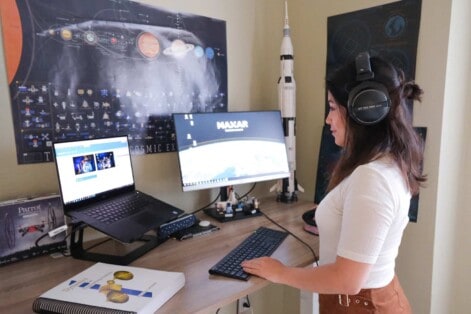
As she contemplated her next move, Miller learned that she had received SWE’s Judith Resnik Memorial Scholarship — an award with a direct connection to the one job that, she said, “still appealed to me more than any other: becoming an astronaut.”
Like Drs. Resnik, Ride, and Walker before her, Miller ultimately decided to stick with her original plan. She enrolled in graduate school at Georgia Tech, earned a master’s in aerospace engineering, and is now less than two years away from completing her Ph.D. in planetary science and aerospace engineering as a National Science Foundation (NSF) fellow.
In graduate school, Miller experienced numerous successes. In 2018, the American Institute of Aeronautics and Astronautics (AIAA) gave her its “best student paper award” for work she submitted to its Propulsion and Energy Forum. The next year, she applied for and received an NSF fellowship — the most competitive fellowship in STEM — to fund her Ph.D. research into the fluid dynamics of the global ocean on Jupiter’s moon, Europa. Then, in 2020, Georgia Tech’s aerospace engineering department honored Miller with its Outstanding Graduate Teaching Assistant Award, and the Journal of Spacecraft and Rockets agreed to publish her paper on optimal mission uses for competing types of small satellite electric propulsion systems.
“None of these accomplishments would have been possible if I had not made the decision to start graduate school,” Miller explained. “I am extremely grateful for the impact that the Judith Resnik Memorial Scholarship has had on my educational journey.”
Miller still hopes she’ll have the opportunity to travel to Mars and beyond as a NASA astronaut. “I would go in a heartbeat, if someone offered me a seat,” she said, “but it’s no longer the only thing that would make me really fulfilled with my career.”
SWE Fundraising Drive Targets Judith Resnik Memorial Scholarship
Since SWE established the Judith Resnik Memorial Scholarship in 1990, the amount of its annual award has quadrupled, from $1,000 to $4,000. Yet, college tuition costs have risen far faster — by a staggering 5.41 times, on average, according to data compiled by the U.S. Bureau of Labor Statistics.
Consequently, the Resnik scholarship has lost about a third of its original value. To help reclaim some of that loss, SWE’s board of trustees has launched a fundraising drive with an immediate goal of increasing the scholarship’s annual award amount “to at least $5,000.”
The drive is part of a larger, general effort to reinvigorate SWE scholarship endowments across the board, said SWE board of trustees member Paula McDonald, who is spearheading the drive. “As the costs of education continue to rise,” she explained, “we want to make all of our scholarships as impactful as possible.” SWE currently awards hundreds of academic scholarships each year, she said, the vast majority of which are in the $1,000 range.
The board of trustees announced the Resnik scholarship fundraising effort in November, during SWE’s virtual WE20 conference. The drive honors this year’s 35th anniversary of the Challenger disaster, which occurred on Jan. 28, 1986.
In an open letter in the 2020 conference issue of SWE Magazine, McDonald outlined the special significance the Challenger disaster holds for SWE members and for women engineers in general. “While tragic,” she wrote, “the Challenger mission was particularly inspiring to a generation of children who went on to pursue thriving careers in STEM fields, including myself!”
The Judith Resnik Memorial Scholarship gives a one-time $4,000 award to any current SWE member, who is a student pursuing an undergraduate degree in either aerospace or astronautical engineering. Applicants are eligible only during their sophomore, junior, or senior years of college.
It takes a $25,000 endowment to support an annually recurring $1,000 scholarship. In the past, McDonald said, that figure may have discouraged SWE members from donating to scholarships, because they feared they would be asked to make large-dollar donations. That, McDonald stressed, is not the case.
“This appeal is not limited to major donors,” she explained. “It’s open to everyone. You can donate $50; you can donate $5 to the endowment. We welcome participation at all levels of giving.”
Those interested in donating to the Judith Resnik Memorial Scholarship can do so online at www.swe.org/scholarships. Under “Donate” and “Select Funds” choose the Judith Resnik scholarship, indicate your desired donation amount, and then complete the pay-by-credit-card form.
SWE also accepts checks made payable to, “The Society of Women Engineers Endowment Fund Inc.” Please mail them to: SWE Endowment Fund Inc., 500 Westover Drive, #15679, Sanford, NC 27330.
Getting there
On paper, Melissa Pardo, a 25-year-old dynamics and controls engineer with San Jose, California-based Maxar Technologies, couldn’t have looked less like a future candidate for an engineering degree. When she arrived in the U.S. in 2012, Pardo, a native of Colombia, was a 17-year-old girl from a highly traditional Latin American background. In other words, in her family culture, girls with an interest in aviation became flight attendants, which her mother had initially suggested she do. They did not aspire to become commercial airline pilots or to pursue technical degrees of any sort. That was men’s work.
Pardo spoke broken English, had an unremarkable high school transcript, and an unrecognized Colombian high school diploma. She and her mother and her two younger sisters lived with their new American stepdad in his hometown of Oologah, Oklahoma, a tiny hamlet of fewer than 1,200 people.
Her academic credentials were limited. Colombia high schools stopped at the 11th grade, so Pardo had to attend free GED-prep classes at the local community college to fill in gaps in her education before taking the test. She passed it the first time. The idea that she could be just a few years away from graduating from San José State University with a 3.93 GPA in aerospace, aeronautical, and astronautical engineering — or that she could somehow acquire the financial wherewithal to help pay her own way through undergraduate school — seemed far-fetched, if not bordering on fanciful.
Yet, shortly after she arrived in Oologah, Pardo told her mother that she had decided to get a job and to pay her own way through university. In January of 2013, at age 18, she took her $700 in savings, packed her belongings into her small car, and took off for California.
Heading for San José, Pardo hoped she could find work in a Hispanic retail store where her broken English might prove to be less of an issue. She rented a tiny, furnished room, talked her way into a sales job at a Hispanic furniture store and obtained a second job as a weekend photographer.
Eight months later, in the fall of 2013, Pardo paid nearly $4,000 to cover her first-semester’s tuition as an out-of-state first-year student at Cabrillo Community College in Santa Cruz. It took Pardo four years to complete her first and sophomore years while honing her language skills on the side. By the end of her first year, Pardo had traded her off-campus furniture store job for a position as a teacher’s assistant in a materials lab class.
She also had become a fixture at the college’s MESA (Mathematics, Engineering, Science Achievement) Center, a resource and support community for minority students pursuing STEM degrees. Later, professors there encouraged her to consider aerospace and aviation engineering. As she often did, Pardo researched the topics online. When she realized both areas applied to NASA engineers, she got excited. “I thought, this sounds interesting,” she recalled. “I’m just going to do it.”
“I never gave myself the opportunity to think about whether it was too hard or not. I simply went for it. Every class that I passed, every good grade that I got, gave me confidence to keep going. When I didn’t do so well,” she said, “I would feel devastated, but [thinking about] my four siblings gave me the strength and motivation to keep going.”
By the end of her second year at Cabrillo, Pardo’s engagement had so impressed the MESA Center faculty members that they recommended her for a STEM Level I Scholarship — worth almost $7,000 — enough to take considerable financial pressure off her during her final semesters at the community college. All she had to do was to keep her GPA above 3.0 and take part in five extracurricular activities.
In 2018, San José State University took notice of Pardo’s GPA and heavy involvement in student activities and offered her a full scholarship, which she said covered “almost everything.” She transferred there and joined the school’s SWE section. While checking out the SWE website, she came across its academic scholarships and applied for two, one of which was the Resnik scholarship. She won both and used them to help cover her room, board, and other school expenses.
The Resnik scholarship had a major impact on Pardo “not only as a student,” she said, “but also as a person and a professional. Going through college without financial support from my family was challenging and, many times, overwhelming. Therefore, I heavily relied on scholarships to keep me focused on my classes and not to worry so much about money. The Resnik scholarship enabled me not only to graduate with excellent grades, but also to lead in my senior design project. Now that I have finally graduated,” she added, “I am eager to inspire other women to pursue engineering, and I hope to get to a point in my career where I also can support other students through college.”
It wasn’t until her junior year that Pardo developed a passion for aerospace engineering and became aware of a special bond that united her with Dr. Resnik. “I was finally taking aerospace classes, and they were all fascinating to me,” she said. “I discovered that aerospace engineering is always at the cusp of technology and innovation, and there is always something new to learn. I think that’s what I love the most: learning.”



